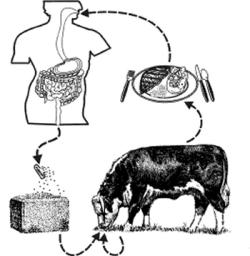| | In cattle | In humans | Life cycle of Taenia saginata | How can I prevent it?
In cattle, the parasite Cysticercus bovis is commonly called bladder-worm or beef measles. This parasite is actually the larvae of the human tapeworm, Taenia saginata.
The prevalence of cysticercosis in cattle in Canada is very low. When outbreaks occur, they are usually associated with a human carrier who has had close contact with cattle or cattle feed.
In Cattle
Cattle are intermediate hosts in the life cycle of this tapeworm, so only the larval stage (cysticercus) develops in the hosts. The infection is also called beef measles, cysticercosis or bladder-worm. Cattle become infected when they eat eggs passed by infected humans.
What to look for in cattle?
The bean-sized cysticerci are oval, grayish-white, fluid-filled bladder-like objects approximately 10 mm long by 5 mm wide. Cysts can be seen with the naked eye between two and four weeks following infection as nodules in the muscle of cattle, particularly in the heart, diaphragm, tongue and masseter. The cysts give the meat a measel-like appearance when they occur in large numbers. Each cyst produces only one adult tapeworm when ingested by humans.
How does it affect cattle?
Cattle of any age are susceptible to infection. No clinical signs occur when only a few cysticerci are present. However, heavy infections may cause myocarditis and heart failure associated with developing cysts in the heart.
What economic losses occur?
The cycticerci can survive in cattle anywhere from weeks to years and can present economic problems to the beef industry. Carcasses containing few cysts must be frozen at -10° C for 10 to 14 days before the meat can be used for human consumption. If many cysts are present, the entire carcass is condemned.
Can cattle be treated?
As yet, there is no licensed drug available that kills all the cysticerci in muscle. Experimentally, praziquantel is effective against cysticerci. Most cysticerci are absorbed within six to nine months following treatment, but residual calcified cysts can remain.
If left untreated, cysticerci begin to degenerate within a few months, and by eight to 10 months, many of the cysticerci are dead and calcified.
In Humans
The adult tapeworm (strobila) develops in the small intestine of man - its only final host. Humans are infected when they eat raw or rare beef containing cysticerci.
What do I look for in humans?
The adult tapeworm can reach a length of up to 12 meters and contain over 1,000 segments (proglottids) each containing between 50,000 and 80,000 eggs. Although a single worm is usually found, multiple worms can be present. In many cases, patients become aware of the infection by noticing segments (proglottids) in their stools.
How does it affect humans?
Many infections are without symptoms, and the carrier may be unaware of their infection. Taenia saginata infection result in mild symptoms such as loss of appetite, nausea, abdominal discomfort, diarrhoea and weight loss. Detached segments crawling from the anus can cause some discomfort.
Can people be treated?
Worms can survive for up to 25 years in the intestine unless removed by medication. Drug therapy is usually very effective, but retreatment may be necessary. Consult your family doctor.
Life Cycle of Taenia saginata
The life cycle of T. saginata depends on the close association between humans and cattle.
Humans become infected with the adult tapeworm by eating raw or rare beef containing bladder worms (Figure 1). The bladder worm is digested out of the meat in the stomach, attaches to the intestinal lining and grows to maturity in two to three months. The tapeworm forms a chain of 1000-2000 segments (proglottids). The egg-bearing segments at the end of the chain break off and crawl from the anus or pass in the stool. One infected person can pass 750,000 eggs each day in their feces as individual eggs or as intact segments, each containing thousands of eggs.
The rest of the parasite life cycle occurs in cattle that become infected by accidentally eating the tapeworm eggs contaminating pastures, hay or drinking water. After being eaten, the embryo (oncosphere) contained within the egg hatches, penetrates the intestinal wall and is carried by the bloodstream to muscles to continue its development. The developing bladder worm is first visible as a tiny, semi-transparent spot about two weeks after infection. These cysticerci continue to develop and become infective to humans in 8 to 12 weeks when the cysticerci have reached full size.

Figure 1. Bladder-worm/tapeworm life cycle
How Can I Prevent it?
The prevalence of cysticercosis in cattle in North America is generally low. Occasionally, outbreaks of cysticercosis do occur. Such outbreaks are often associated with using human sewage on pasture. Sludge from sewage used as fertilizer on pasture is a potential source of viable tapeworm eggs to grazing cattle.
Cattle should not be allowed to graze on pasture contaminated with human sewage. Egg viability can range from 16 days in untreated sewage to 159 days on pasture. The eggs of T. saginata can remain viable in the soil for days to weeks.
Other causes of outbreaks occur when cattle gain access to water contaminated with sewage effluents or the spread of T. saginata eggs by birds that frequent sewage outlets or feed on effluent discharge. Water used for livestock purposes (e.g. drinking, irrigation) should be free of fecal contamination.
Since human infection is acquired from eating raw or rare beef, all beef prepared for human consumption should be thoroughly cooked.
Prepared by:
Murray J. Kennedy, Ph.D - Food Safety Division
Source: Agdex 655-7. Revised October 2005 |
|